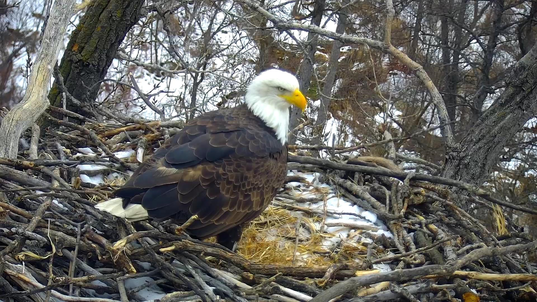|
January 29, 2021

January 28, 2021: New Beginnings
Once again, life on our eagle nest has changed. Our resident female is still on territory, but the male with which she reared three chicks last year, has not returned. She has chosen a new, younger mate. We know this eagle is young because he has yet to develop a full white head and tail. His head and tail appear a little dirty, with flecks of brown mixed in with the white.
The pair have been together for several months now and appear to have bonded, as well as mated. Their activity on the nest has been limited in recent days. For several weeks, the two could be spotted making upgrades to their humble abode. Moving sticks, bringing in new "furniture" and grasses are all part of the courtship behaviors that eagles engage in during the mating season. Other behaviors are observed as well. The resident female took a while to warm up to her new mate. Nibbling on his beak or playfully nipping can be considered part of the courtship process. Gathering sticks, making improvements and later, bringing food to the nest are actions the female judges to be desirable in a worthy choice for a mate.
This week, on-camera activity has slowed. While the new couple has been observed keeping close together and actually mating, they have not been around the nest more than a couple of times a day. They are likely close by, protecting their territory from a barrage of inevitable visitors to and around the nest. The visitors are typically other eagles of various ages coming to check out the scenery. The resident birds have usually escorted these visitors away, signaling that this is their territory and to let them know they are not welcome.
Seven swans a-swimming
The pond below the nest is naturally spring-fed so it rarely freezes over during cold winter months. Trumpeter swans - last count seven - have taken up temporary residence in the pond's open water. Since there hasn't been much eagle activity on the nest, we occasionally swing the camera around to watch the swans foraging for food at the bottom of the pond. You can watch the swan butts bobbing on the camera and they will likely stay as long as the water remains open and there is ample food for them.
The population of trumpeter swans in Minnesota is a Nongame Wildlife Program success story. Your donations to our program helped this majestic species recover from the brink of extinction. In the 1970's, they were all but gone from the state. Your dollars purchased airfare for eggs brought in from Alaska to be hatched, reared and eventually released into the wild. Now, approximately 30,000 trumpeters call Minnesota home.
We want to thank you for your continued support of the Nongame Wildlife Program. We rely on your contributions and we just couldn't do our important work without your support. YOU make our program and we thank you!
|